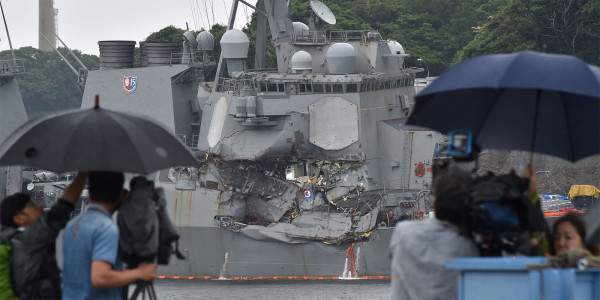

Japanese investigators believe the crew of the USS Fitzgerald was in full damage-control mode, stanching the flow of seawater into the destroyer’s compartments, and without reliable communications for as much as an hour after the warship was crippled by its impact with a commercial container ship last week.
That theory of events is still preliminary, the U.S. Naval Institute reports, but Japanese officials believe it explains the movements of both ships in the aftermath of the collision, which killed seven Fitzgerald sailors and wounded three, including the commanding officer, Cdr. Bryce Benson. USNI News explains:
According to the current operational theory of Japanese investigators, the deadly collision between USS Fitzgerald (DDG-62) and the Philippine-flagged merchant ship ACX Crystal knocked out the destroyer’s communications for an hour, while the four-times-larger merchant ship was unaware of what it hit until it doubled back and found the damaged warship, two sources familiar with the ongoing Japanese investigation told USNI News on Wednesday.
Those investigators believe the Crystal, en route to Tokyo, was cruising on autopilot at the time of the collision, when its bow dug into Fitzgerald’s superstructure amidships on the starboard side around 1:30 a.m. local time on June 17. “When the crew of Crystal realized they had hit something, the ship performed a U-turn in the shipping lane and sped back to the initial site of the collision at 18 knots,” USNI News reports. On discovering the ailing destroyer, Crystal contacted authorities by radio around 2:30 a.m. local time — about the same time that U.S. Navy officials said the collision occurred in press briefings over the weekend.

The container ship ACX Crystal with its port bow dented and scraped after colliding with the USS Fitzgerald in the waters off the Izu Peninsula on Saturday, June 17, 2017.Hiroshi Kashimura/Kyodo News via AP
A Fitzgerald sailor told USNI News that around the same time Crystal arrived onscene, the destroyer got its backup satellite radio working and sent its own SOS message.
The damage was devastating to Fitzgerald. The captain’s stateroom was completely crumpled and Benson, who was sleeping at the time, was pushed outside the ship’s skin and required a complex rescue. He was rushed for medical attention at the U.S. naval base at Yokosuka, Japan, about 60 miles from the collision site. Photos circulating on social media showed the destruction to Benson’s stateroom:
Below the waterline, damage was extensive and threatened to sink the ship. “The ship suffered severe damage rapidly flooding three large compartments that included one machinery room and two berthing areas for 116 crew,” Vice Adm. Joseph Aucoin, 7th Fleet commander, said in a weekend press conference. One Fitz sailor told USNI that the hull breach was “10-feet-by-10-feet to 14-feet-by-14-feet.” The sailors who died were in their berthings.
The U.S.’s investigation of the incident is likely to focus on why the Fitzgerald, steaming under normal operations, didn’t catch a surface contact as large as the Crystal sooner on radar or through a visual fix. Experienced surface warfare officers tell Task & Purpose that the fact that the ship’s captain was asleep and not on the bridge suggests the Fitzgerald’s watchstanders saw nothing amiss before the collision.

USS Fitzgerald returns to Fleet Activities Yokosuka following the collision off the coast of Japan.U.S. Navy/Mass Communication Specialist 3rd Class Kryzentia Weiermann
As devastating as the fatal incident was, it could easily have been much worse. All Navy crews are trained extensively in damage control and emergency operations underway; that training may have kept the ship afloat and prevented more sailors from dying in the collision’s aftermath.
“The Fitzgerald crew responded professionally as all Sailors are expected to fight the damage sustained to their ship,” Aucoin said. “They are known as the ‘Fighting Fitz,’ and the crew lived up to that name.”
WATCH MORE:
